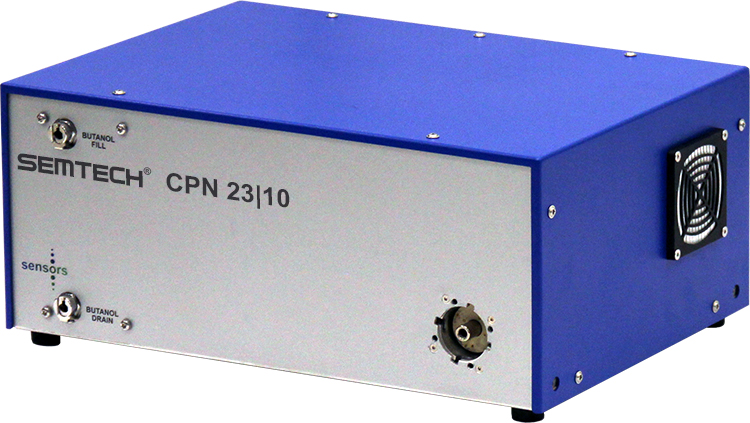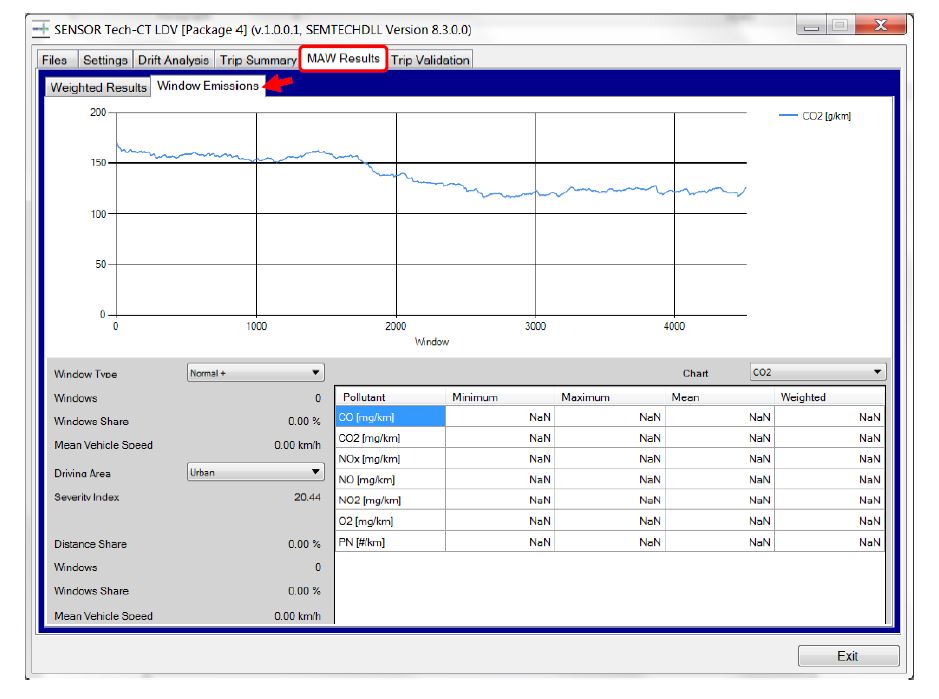Newsletters
September 2020 Edition
Meeting the 10nm Particle Number Testing Challenge
Following a successful engineering development and validation program, Sensors is pleased to introduce its new dual range particle number-based analyzer, the SEMTECH® CPN 23|10, in anticipation of new regulations. Testing at Ricardo Energy & Environment confirmed that this SEMTECH® module can now measure particles down to 10nm as well as 23nm. The user can choose the desired range with a simple software/pneumatic switch.

Current regulations for Particle Number (PN) RDE measurement devices require the particle counting efficiencies at various particle sizes be within a set range (currently analyzers must have a d50 of 23nm, i.e. devices measure 50% of 23nm particles). There is a drive, however, to reduce that key parameter to 10nm with the implementation of post-Euro VI regulations (or potentially in a Euro VIe amendment), due to the well-documented effects of smaller particles on human health. In a recent study carried out by the European Commission’s Joint Research Centre in ISPRA, several PN PEMS (including a modified 10nm Sensors CPN) were successfully evaluated and new efficiencies down to 10nm were proposed.
Although a fixed CPN with a d50 of 10nm is a useful addition to the SEMTECH® product range, a single CPN capable of being able to measure either 10nm or 23nm was identified as an engineering goal in late 2019, and the program to develop this key option initiated.
The new SEMTECH® CPN 23|10 is designed and manufactured to fully comply with current world-wide regulations for RDE PN measurements, notably the size efficiency requirements from 23 to 200nm. The proposed new efficiency requirements extending measurements down to 10nm can also be measured through a user selectable flow path and software switch to incorporate the second calibration factors. Similarly, the metrology information at this extended range can also be provided by an accredited calibration laboratory.
This device is switchable, allowing the user to change the desired range with a simple pneumatic / software selection. “This innovative device allows our customers to understand the challenges presented by current and future regulations and to develop systems that meet those challenges well in advance of their implementation,” says David Booker, Chief Technical Officer, Sensors, Inc. This new SEMTECH® feature is now available as an option with the SEMTECH® CPN, and current SEMTECH® CPN modules in the field may be conveniently upgraded during annual maintenance/calibration.
Contact your SEMTECH® representative for further details.
Shaping the Future of Clean Mobility
The global community is in the early stages of a fundamental transition from fossil fuels to alternative and/or renewable sources of energy in the mobility sector, and vehicle manufacturers (and society) are faced with various challenges ranging from energy availability, refueling and recharging infrastructure to powertrain and emission control system design. Parallel activities by various industry sectors, as well as, a legal framework and roadmap will be needed in addition to the innovative power of the automotive sector to successfully manage this transition process.
In December 2019, the European Commission published its “Communication on The European Green Deal”, which describes a pathway to zero emission mobility by 2050. A phase-out of traditional combustion engines powered by fossil fuels is projected to start in Europe in 2030. This means that hybrid, petrol- and diesel- fueled vehicles will continue to provide practical mobility solutions for Europe in the next 20+ years, and for longer on a global scale.

Creating a variety of mobility offerings which suit every need can be achieved by future vehicle legislation which is based on technology- and fuel- neutral approaches. Consequently, the work on post Euro 6/VI regulations has begun aiming to define more stringent air pollutant emissions standards by 2021. The Advisory Group Vehicle Emission Standards (AGVES) has been formed to provide technical advice, data and other information in the drafting stage. This process is supported by the Consortium For Ultra Low Vehicle Emissions (CLOVE), a group of seven European Research Institutes, which won a tender from the European Commission. Its goals are to review international emission regulations, to assess the effectiveness of current European Emission Standards and to develop a new array of tests.
The group has preliminarily identified issues which offer potential for improvement over the current Euro 6/VI regulation. These include a high need for simplification of the legislation, a match of limit values with state-of-the art emission reduction technology, and further focus on real world emission measurement using PEMS. A stringent post Euro 6/VI regulation is also needed to prevent further de-harmonization of emission regulations in the European Community caused by the introduction of local, regional or national pollution reduction measures.
Specifically, the following measures were identified to improve the quality and/or frequency of measured data:
- Focus on PEMS testing over testing in laboratories.
- Surveillance Monitoring by independent parties.
- Testing vehicles throughout their useful lives by independent Periodic Technical Inspection (PTI) schemes using On-Board Diagnostics (OBD) and tailpipe testing extended to PN and NO/NO2.
- Introduction of On-Board Measurement (OBM) to immediately flag out emission exceedance for corrective action.
In order to further improve air quality a bundle of additional measures is currently being considered and under review:
- Lowering limit values for NOx to account for the emission reduction potential of the latest exhaust after treatment strategies.
- Adding new pollutants with appropriate limit values to reduce detrimental effects on global warming, air quality and health: ammonia (NH3), nitrogen dioxide (NO2), nitrous oxide (N2O), methane (CH4) as well as carcinogenic chemicals such as formaldehyde and acetaldehyde.
- Extending particle number counting to sub 23nm particles during type approval and real-world measurements. In parallel, the feasibility of tighter counting efficiency tolerances is being examined. Besides combustion generated particles also particles from brakes and tires are coming into focus.
The introduction of the Euro 6d regulation adding real world emission measurements to the type approval criteria has had a major impact on improving air quality. A carefully designed, technology and fuel neutral, effective and efficient post Euro 6/VI regulation could contribute further to reducing global warming and to improving air quality during the transition to carbon free mobility.
Sensors will continue to monitor and to contribute to the post Euro 6/VI regulation drafting process and is committed to provide the necessary instrumentation and services to ensure that exhaust emissions can be analyzed and quantified in laboratories, in real world driving, in inspection centers and in service stations globally throughout the useful life of a vehicle
Oliver Franken
Managing Director of Sensors Europe GmbH
June 2020
Learn more about Sensors, Inc. and our Portable Emissions Measurement Systems (PEMS) and Testing Services by visiting our web page www.sensors-inc.com.
Tips for testing
This edition of our newsletter again provides Tips for Testing from our Applications Group on running successful in-use tests, drawing on their extensive experience with a wide variety of applications. Twenty years of experience operating SEMTECH® systems, and contributing to the design and development of the most advanced and innovative PEMS. This edition provides tips on Data QA.
Data QA Tips
Plot data and look for the following:
- Diesel fueled vehicles: CO2 concentrations should reach 12% when vehicle’s LOAD PERCENT is 100%. Gas concentrations should read near zeroes when vehicle is decelerating since it’s pushing air thru the engine.
- Petrol/Gasoline fueled vehicles: CO2 concentrations should reach above 15% when vehicle is cruising. CO2 concentration should dip down during deceleration (~10%).

- CO2 concentration shouldn’t be higher than 14% for diesel fueled vehicle (unless in a DPF regeneration), or above 15.8% for petrol/gasoline fueled vehicles.
- Plot Calculated Sensors Fuel Rate against ECM Fuel rate: correlation between the two should be within single digit percentages.
- Plot ECM based Flow against EFM Flow Rate: Differences between the two should be less than 15% since EFM Flow Rate contains ECM Mass Air Flow value added to the Fuel Flow Rate.
Resources
“A European Green Deal.” European Commission - European Commission, 18 Aug. 2020
ec.europa.eu/info/strategy/priorities-2019-2024/european-green-deal_en
Assessment of 10-Nm Particle Number (PN) Portable Emissions Measurement Systems (PEMS) for Future Regulations.” EU Science Hub - European Commission, 10 June 2020
ec.europa.eu/info/strategy/priorities-2019-2024/european-green-deal_en